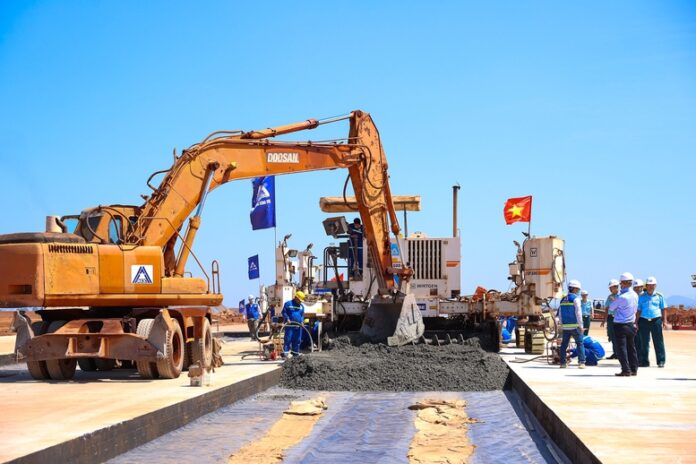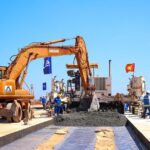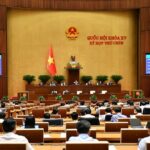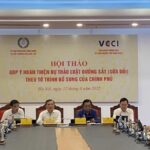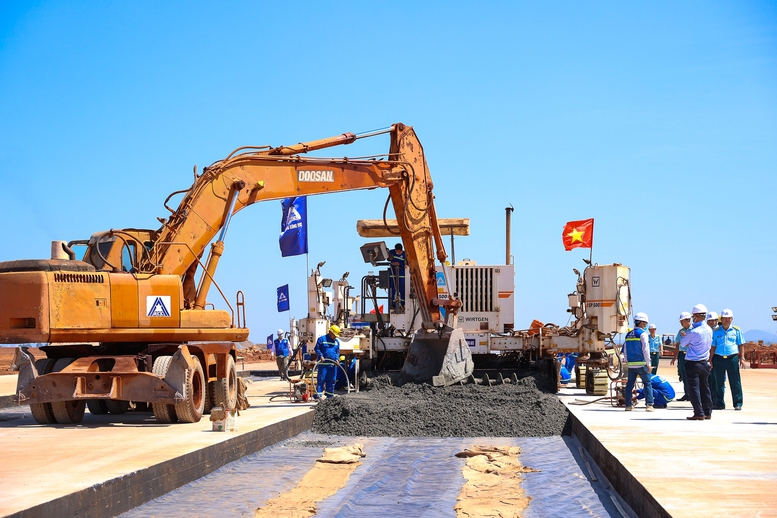
The Ministry of Construction proposes a six-lane expansion of the North-South Expressway with a total investment of approximately VND 152,102 billion.
Proposing to Expand 18 Sub-projects
According to the Ministry of Construction, the North-South Expressway Eastern Route is approximately 2,063 km long. It starts at Huu Nghi Border Gate, Lang Son Province, and ends in Ca Mau City, with a scale of 6 to 12 lanes.
So far, 1,443 km of the route has been put into operation, and about 597 km is under construction (by the end of 2025, 554 km will be completed, with 43 km remaining), mainly limited to four lanes.
Some sections are being studied and invested in according to the complete expressway scale, such as Cau Gie – Ninh Binh, Cao Bo – Mai Son, Cam Lo – La Son, La Son – Hoa Lien, Ho Chi Minh City – Long Thanh, and Ho Chi Minh City – Trung Luong – My Thuan.
On this expressway, in addition to the sections being expanded, by the end of 2025, there will be about 1,222 km of four-lane limited sections, mainly on the Mai Son – Cam Lo, Quang Ngai – Vinh Hao, and My Thuan – Ca Mau routes.
Based on the investment principles and criteria, the Ministry of Construction has proposed focusing on prioritizing the expansion of the Hanoi – Ho Chi Minh City section to meet expressway standards.
Within this scope, there are 18 sub-projects invested according to the National Assembly’s resolutions. Of these, eight sub-projects were invested in the 2017-2020 period, and ten sub-projects are in the 2021-2025 period, with a total length of 1,144 km.
In terms of scale, to avoid multiple investments, the Ministry of Construction proposes a six-lane expansion according to the planning with a total investment of approximately VND 152,102 billion.
PPP Investment with High Feasibility
According to the Ministry of Construction’s research, in the case of separating the sub-projects as implemented previously and investing in the entire 18 sub-projects under the BOT format, the preliminary calculation of the financial plan shows that four sub-projects invested with public capital in the 2017-2020 period, with a length of 255 km and a total capital of about VND 26,718 billion (the Mai Son – National Highway 45, National Highway 45 – Nghi Son, Nghi Son – Dien Chau, and Phan Thiet – Dau Giay sections) are gateways with the highest transport demand, with a toll collection period of about 3-13 years, and do not need state budget support.
There are three sub-projects invested under the BOT format in the 2017-2020 period, with a length of 178 km and a total investment of about VND 25,343 billion (the Dien Chau – Bai Vot, Nha Trang – Cam Lam, and Cam Lam – Vinh Hao sections) because investors have mobilized resources for implementation. There will be certain difficulties in continuing to mobilize resources to expand to a six-lane scale.
There are 11 sub-projects invested with public capital (ten sub-projects in the 2021-2025 period and one sub-project in the 2017-2020 period, with a total length of 711 km), with a total investment of over VND 100,000 billion, which are basically sections with low transport demand.
In the case of PPP investment in the expansion, the average toll collection period is about 27 years, and some projects face financial challenges (Quy Nhon – Chi Thanh) and require state budget support.
As the public investment capital that has been and is being deployed accounts for about 57% of the total investment scale of six lanes (in the case of PPP investment in the expansion with state budget support, this ratio may be higher) and to meet the goal of promoting public investment disbursement, the Ministry of Construction has reported to the Prime Minister to consider continuing to expand with public investment capital. After completion, tolls will be collected as required by the National Assembly.
“This option has the advantage that the service price is decided by the State (not for profit) and can ensure a balance of interests between the State, people, and enterprises, suitable for the affordability of most people, and ensure reasonable transport costs on the most important route of the country,” said the Ministry of Construction.
Regarding the PPP investment option, the Ministry of Construction said that, in the spirit of Resolution No. 68, the Ministry has studied options for investing in the expansion of the expressway in accordance with the direction of the Deputy Prime Minister, including the construction-business-transfer (BOT) contract format and the combination of the business-management (O&M) and BOT contract formats.
Based on the evaluation of the advantages and disadvantages of the investment options, investing in the expansion in the BOT format is highly feasible. When implementing, it can be divided into some large-scale projects (such as dividing into two projects in the northern and southern regions) to ensure unity and synchronization.
However, PPP investment faces certain challenges due to the involvement of many transport demand parameters (assumptions about macroeconomic growth, infrastructure investment scenarios in the future…), and these results are based on forecast data, which may differ from reality, especially in the new era of the country (changing growth rates, merging localities, accelerating the progress of high-speed rail investment…).
If investors are not attracted, more time will be lost, or if the PPP investment is not successful and the state still has to support it, it will not be effective.
Proposing to Collect Tolls from January 2026
Based on the analysis, the Ministry of Construction proposes that the Government leaders consider and allow the organization of toll collection on the sections invested with public capital according to regulations to refund the central budget (expected to organize toll collection from January 2026). In case an investor is selected to implement the expansion under the PPP format, the toll collection will be handed over.
During the toll collection process, based on the actual situation, the PPP format will be implemented on some sections. Consider studying the option of forming some large-scale projects (in the northern and southern regions).
The Ministry of Construction believes that this option ensures unity and synchronization throughout the investment process, optimizes management, operation, and exploitation costs throughout the project life cycle, and can attract investors with strong financial potential who are ready to accompany the project for the long term. The time to implement the expansion should be considered after the completion of the warranty period by the contractors according to the previous public investment projects to avoid legal disputes and limit public misunderstanding about the reconstruction of items that have just been completed.
“Proposal to Expand the North-South Expressway via PPP Model”
The Ministry of Construction has reported on the research and investment into expanding the North-South Expressway Eastern Route through a public-private partnership (PPP) model.
Optimizing the Railway Act: A Comprehensive Review and Suggestions for Improvement
The railway industry has long been stagnant, failing to keep pace with the rapid development of other transport sectors. The proposed amendments to the Railway Law are of paramount importance and are expected to offer significant opportunities for Vietnamese businesses to get involved in infrastructure and vehicle development.
What Does the Ministry of Construction Have to Say About the Assignment of Contracts for the Sale of Future Dwellings?
According to the Ministry of Construction, sales contracts for future-built homes that have not yet submitted applications for ownership certificates can still be transferred in accordance with real estate business regulations.

